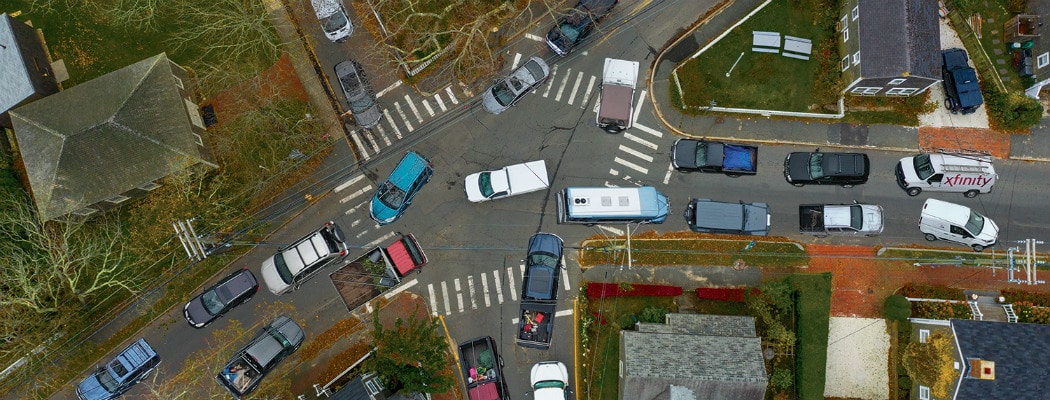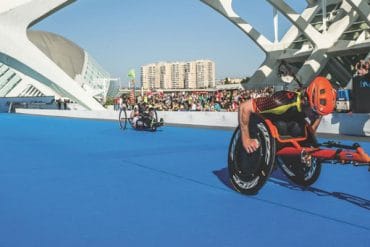Is there a key to solving Nantucket’s summer gridlock?
You didn’t have to be hovering over Nantucket in a news helicopter to see that traffic hit an all-time high this summer. Come July and August, navigating through downtown could eat up your entire lunch break. Like a bad cold, this congestion spread to the rotaries, intersections and other traffic pressure points around the island. Addressing this rise in gridlock has plagued town planners for more than a decade. Theories abound. Do we need to increase the number of parking spots? Should we limit the number of vehicles allowed on the island? Or is summer traffic yet another inevitable consequence of an increasingly popular tourist destination?
 For Alan Worden and his team at the Nantucket Data Platform (NDP), addressing these questions comes down to crunching the numbers. Since launching two years ago, NDP has tackled some of the island’s biggest mysteries—such as how many people actually live on Nantucket—by aggregating, sorting and studying data. Over the course of this year, NDP has turned its attention to traffic through a multipronged approach. “We haven’t done a historical analysis where we have directly measured congestion from previous years; however, our indicators are confirming everyone’s experience that it has gotten worse over the last five years,” says Anna Tapp, the lead data scientist at NDP. “The volume of cars and people have both gradually climbed each year since 2014, with the summer of 2019 being worse than the summer of 2018.”
For Alan Worden and his team at the Nantucket Data Platform (NDP), addressing these questions comes down to crunching the numbers. Since launching two years ago, NDP has tackled some of the island’s biggest mysteries—such as how many people actually live on Nantucket—by aggregating, sorting and studying data. Over the course of this year, NDP has turned its attention to traffic through a multipronged approach. “We haven’t done a historical analysis where we have directly measured congestion from previous years; however, our indicators are confirming everyone’s experience that it has gotten worse over the last five years,” says Anna Tapp, the lead data scientist at NDP. “The volume of cars and people have both gradually climbed each year since 2014, with the summer of 2019 being worse than the summer of 2018.”
Lack of available parking appears to be one of the leading causes of downtown traffic. Cars drive around aimlessly searching for spots, creating congestion at intersections and parking lots. When analyzing the downtown parking lots by the Stop & Shop and the Harbormaster, for instance, NDP discovered that cars were ten times more likely to pass through those lots without ever finding a spot in August compared to January. To alleviate this congestion, the Town of Nantucket has a long-term goal of creating a fifteen percent surplus in available parking spots. The question then becomes: How many additional spots will be needed?
The answer has been a moving target. In 2010, for example, the Nantucket Planning and Economic Development Commission hired Tetra Tech Rizzo, a global consulting and engineering firm, to determine how many more spaces were needed to meet the rising parking demand at that time. Tetra Tech came back suggesting a range between seventy-seven and 671 additional spaces, depending on which method they used to determine the demand. Today, NDP hopes to come up with a more accurate number by observing activity in the various parking lots and counting the number of cars seeking spots that never find one.
Adding parking spaces downtown is not a new idea. In 2007, a proposal was submitted to the Select Board for a multistory parking garage to be built on land located behind the downtown Stop & Shop. Since the 1960s, Harbor Fuel Oil Corporation has operated a tank farm on that land through a long-term lease with Winthrop Management. The proposed development known as Wilkes Square included a four-story parking garage abutting mixed-used buildings. Yet, the idea of replacing an unsightly tank farm with a perhaps equally unsightly parking garage was met with mixed reviews, leading the proposal to evolve at least two times over the ensuing years.
 In 2017, the Town of Nantucket signed an agreement with DESMAN Inc.—a national design corporation that specializes in parking facilities—to evaluate the structural, functional and fiscal feasibility of a new development in this tank farm location that would include green space, mixed-use buildings and additional parking. The plan for the Harbor Place Intermodal Transportation Center has been nurtured through a public-private partnership between the Town of Nantucket, National Grid, New England Development, Winthrop Management and ReMain Nantucket. This November, the first major step toward making Harbor Place a reality occurred as Harbor Fuel’s license to operate downtown officially ended and the company began relocating its tank farms to a new location out of town. Assuming the old tank farm is removed from downtown, the next steps to creating substantially more parking might finally get moving.
In 2017, the Town of Nantucket signed an agreement with DESMAN Inc.—a national design corporation that specializes in parking facilities—to evaluate the structural, functional and fiscal feasibility of a new development in this tank farm location that would include green space, mixed-use buildings and additional parking. The plan for the Harbor Place Intermodal Transportation Center has been nurtured through a public-private partnership between the Town of Nantucket, National Grid, New England Development, Winthrop Management and ReMain Nantucket. This November, the first major step toward making Harbor Place a reality occurred as Harbor Fuel’s license to operate downtown officially ended and the company began relocating its tank farms to a new location out of town. Assuming the old tank farm is removed from downtown, the next steps to creating substantially more parking might finally get moving.
In the meantime, the Select Board is targeting next summer’s traffic by installing a new paid parking system downtown. Using a smart phone app and on-street kiosks, motorists will pay for parking by the minute. The hope is that paid parking will increase the turnover rate of spaces while also discouraging motorists from parking in a spot all day. The money brought in by this paid parking will be directed toward bolstering Nantucket’s public transportation (NRTA), another long-term strategy in reducing traffic. While some on the board are optimistic that paid parking will reduce traffic, others remain skeptical and see the only solution to come by way of increasing spaces.
Another theory to curbing traffic is to simply limit the number of cars allowed on the island. “Obviously the more vehicles on the road, the more congestion,” Anna Tapp writes. “The more vehicles on the island, the higher the potential congestion. However, is the number of vehicles on the island the best predictor of congestion?” In other words, will reducing the number of cars on the island effectively reduce traffic? The short answer, according to NDP, is no. “We found that the number of vehicles that come and go from the island does not well account for the variation in congestion,” Tapp writes. “However, the number of people on the island at any given time is a stronger predictor of congestion than anything else.”
 In fact, during the depths of winter in December, when traffic is at its lightest, NDP found that there are 6,700 more cars on the island than there are people. Meanwhile, in August, there are 12,700 more people than there are cars. “Our key takeaways are that vehicles, in and of themselves, carried to and from the island on the ferry, do not directly lead to the traffic congestion,” Tapp writes. “Rather, it is the changes in population and behavior between summer and winter that cause the drastic changes islanders experience.”
In fact, during the depths of winter in December, when traffic is at its lightest, NDP found that there are 6,700 more cars on the island than there are people. Meanwhile, in August, there are 12,700 more people than there are cars. “Our key takeaways are that vehicles, in and of themselves, carried to and from the island on the ferry, do not directly lead to the traffic congestion,” Tapp writes. “Rather, it is the changes in population and behavior between summer and winter that cause the drastic changes islanders experience.”
NDP’s data scientists also monitored twenty-seven intersections to see if it was possible to create a model that could predict congestion at these specific locations. “The sample included both major arteries and residential intersections across the island,” Tapp writes. “The pilot test was successful [as] we were able to predict the congestion at these 27 intersections based on a model.” This data was used to create a key performance algorithm that could eventually help determine whether future changes to infrastructure and behavior actually improve the traffic situation.
The one unifying takeaway from the years of traffic studies and proposals is that there’s no quick fix. Like addressing sea-level rise and the housing crisis, summer traffic is yet another monumental challenge facing this small island. The good news is that whether sought through effective paid parking strategies or a dramatic new parking structure, solutions to summer traffic might not be much further down the road. “It feels like the town is willing to try a variety of tactics to alleviate the problem and that’s great,” says Alan Worden. “But to understand the efficacy of any initiative you need base data that is regularly updated. Without that, it’s mostly anecdotal and that’s a ‘four letter word’ at NDP. Data and analytics lead to evidence-based decisions. As we like to say, ‘Critical policy decisions shouldn’t be anyone’s guess.’”








